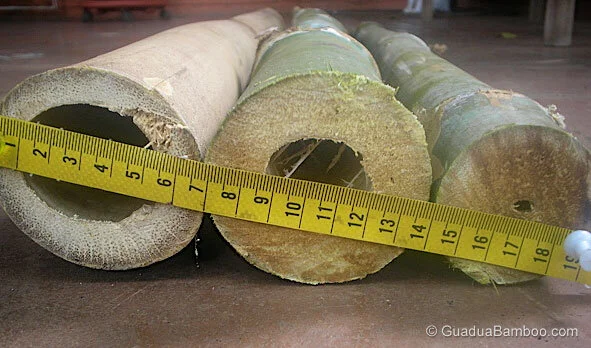
Bamboo Forum
From planting to building, browse questions and
trusted answers from real bamboo experts.
What Determines the Length of Bamboo Internodes?
What determines the length of bamboo internodes? Is it the species only, or are there other factors involved?
What determines the length of bamboo internodes? Is it the species only, or are there other factors involved?
⭐ Best Answer:
The length of bamboo internodes varies greatly from species to species, and the climate and soil it is grown in. Also, bamboo internodes are much shorter towards the base and tip of the culm (stem) compared to the internodal length in the middle of the culm.
Generally speaking the more nodes, the stronger the bamboo. A bamboo culm is at its strongest at the base (largest diameter, more nodes, thickest walls), that's because it has to support the weight of the entire culm, branches and leaves.
So why are the internodes also short toward the tip of the bamboo? This has two reasons:
The branches grow from the nodes. Most bamboo species have little to no branches in the middle of the culm, but primarily at the top, and sometimes near the base. That's why there are more nodes and shorter internodes at the top.
Since there is a lot of weight from branches and leaves at the top, it also has to be strong and flexibel. Hence, lots of nodes and short internodes.
How Many Internodes Has an Average Bamboo Culm?
How many internodes has an average bamboo culm?
How many internodes has an average bamboo culm?
⭐ Best Answer:
In BAMBOOS OF THAILAND there are several tables in which the number of culm-nodes and their corresponding culm length above the ground, the number of internodes, their length, diameter and wall width are listed.
Such tables are available of the following species:
Bambusa pervariabilis, Bambusa textilis, three unidentified Bambusa species, Cephalostachyum pergracile, three unidentified Dendrocalamus species, Lingnania distegia, one unidentified Schizostachyum species, and ×Thyrsocalamus liang.
Is Beema Bamboo a Solid Bamboo?
I'm wondering about how true the claims of total solidity of some species or varieties of bamboo actually are. e.g. Bambusa balcooa var 'Beema'. Is it a case of mostly solid starting from the base up or total solidity? Or is it just an occasional occurrence even in monoclonal cultivars?
I'm wondering about how true the claims of total solidity of some species or varieties of bamboo actually are. e.g. Bambusa balcooa var 'Beema'. Is it a case of mostly solid starting from the base up or total solidity? Or is it just an occasional occurrence even in monoclonal cultivars?
I know this site refers to Guadua angustifolia but it is also one of the best bamboo resources I've found online in terms of plain presentation of facts rather than the standard sales pitch so I figured where better to ask.
⭐ Best Answer:
100% solid bamboo (the entire culm) doesn't exist as far as I know, except maybe for some small diameter bamboo in the genus Chusquea.
In the genus Guadua there also exist a near solid species called Guadua amplexifolia (see photo), which starts nearly solid at the base, however a small cavity the size of a pencil is still present. Towards the middle and top of the culm the bamboo becomes hollow again, although the wall thickness remains fairly thick.


